NaturaConnect - Building a resilient ecological network of conserved areas across Europe for nature and people

Duration: July 2022 – June 2026
Lead Partner: International Institute for Applied System Analysis (IIASA)
Funding: Horizon Europe
Project website: naturaconnect.eu
Project description
Europe needs healthy ecosystems that benefit biodiversity and people and are resilient to climate change. The Horizon Europe NaturaConnect Project will support European Union governments and other public and private institutions in designing a coherent, resilient and well-connect Trans-European Nature Network.
In October 2020, European Union Member States committed to legally protect a minimum of 30% of the European Union’s land and sea area and to strictly protect at least a third of these protected areas. This is expected to contribute to the European Green Deal’s goal of preserving and restoring Europe’s natural capital and taking a leading role in the Post-2020 Convention on Biological Diversity (CBD) Framework. One of the cornerstones of this strategy is to develop a coherent Trans-European Nature Network (TEN-N) to function as a connected system through ecological corridors with natural and semi-natural areas, which, if appropriately managed, can deliver a wide range of benefits for biodiversity and people.
To help the European Union and its Member States to realize their ambitious strategy for protected areas, the European Union Horizon Europe Research and Innovation Programme has funded a new project called NaturaConnect. The Project brings together experts from 22 partner institutions, jointly coordinated by the International Institute for Applied System Analysis (IIASA), the German Centre for Integrative Biodiversity Research (iDiv) and Martin Luther University Halle-Wittenberg (MLU).
Working closely with protected area managers, conservation organizations, and other stakeholders, the project team will conduct research, engagement, and dissemination activities across Europe to identify the best areas to protect and connect to preserve biodiversity and adapt to climate change. The team will also work with national and sub-national nature conservation agencies and other stakeholders within six case studies to test and refine their approaches and inform local ongoing conservation efforts. One such example is the Carpathian-Danube region, where NaturaConnect will evaluate the connectivity design and implementation challenges in a transboundary area encompassing ten different European Union countries.
By working with key decision makers, policy experts, and other important stakeholders, NaturaConnect will create a strategic plan for realizing an ecologically representative, well-connected network of conserved areas that contribute to achieving the objectives of the European Union Biodiversity Strategy to 2030. The project aims to:
- Support planning authorities, by collecting and making accessible the best available data and tools to assess biodiversity and the benefits to people
- Provide input to planning authorities into the design of an effective Trans-European Nature Network by anticipating future developments in climate and land use conditions that may limit or enable the development of such a network
- Identify alternative configurations of protected areas and corridors based on preferences related to policy targets
- Identify opportunities and challenges to the implementation of the network, mechanisms, and instruments of implementation, particularly financial instruments and ways to mitigate barriers through extensive dialogue with practitioners, capacity building, and decision support
- Showcase applications of the protected area network design through case studies
The Danube-Carpathian transboundary region – Case Study
The transboundary region of the Danube-Carpathian is recognized as a pivotal ecological area in Europe. Its significance lies in the presence of breathtaking wilderness areas and some of the last extensive tracts of untouched, natural forests. Notably, this region serves as a sanctuary for a substantial portion of Europe’s brown bear, European lynx, and grey wolf populations, with two-thirds of these species finding refuge within its borders.
Nevertheless, this remarkable biodiversity hotspot faces imminent threats from unsustainable economic development. The planning and execution of new roads, urban expansion, intensified agricultural and forestry practices, energy infrastructure, and tourism development often occur without due consideration for nature conservation, notably neglecting protected areas and ecological connectivity. As a consequence, land use alterations and river regulations contribute to the fragmentation of habitats for terrestrial and freshwater wildlife.
There is a need for coordinated spatial planning across sectors to safeguard what is still in good natural conditions and to restore what has been destroyed in the past. In this context, the establishment of a Trans-European Nature Network (TEN-N) as required by the EU Biodiversity Strategy 2030, is pursued. The International Commission for the Protection of the Danube River brings together water managers from 14 countries sharing the Danube basin, and the Carpathian Convention engaging stakeholders from the seven Carpathian countries in sustainable development, provides good cooperation platforms for the project, along with the EU Strategy for the Danube Region.
The overarching objective of this case study is to promote transboundary and cross-border cooperation through a comprehensive, whole-of-government approach for planning the Trans-European Nature Network (TEN-N) and projects/initiatives focused on ecological connectivity, in accordance with the Ecological Connectivity Declaration endorsed in 2022. The ultimate outcome will be the formulation of a strategy aimed at establishing a robust ecological network comprising green and blue infrastructure, with consideration for potential financing mechanisms within the region. To achieve this goal, active engagement with pertinent working groups of the Carpathian Convention, the International Commission for the Protection of the Danube River (ICPDR), and the EU Strategy for the Danube Region will be undertaken.
In this respect the project team will facilitate dialogue of stakeholders on building the TEN-N based on existing planning instruments and ongoing work on connectivity, while introducing the results of the NaturaConnect project, in particular the prioritisation and connectivity analysis for this cross-border region. Co-create and facilitate feedback to NaturaConnect project deliverables to integrate people’s views, knowledge and experience, and touch ground, most importantly related to the development of a map presenting green and blue infrastructure in the region.
Regarding the Carpathian Convention, the project will:
- Support the revision of the Carpathian Convention Action Plan on conservation of large carnivores and ensuring ecological connectivity
- Support the development and implementation of the Carpathian Biodiversity Framework
Project deliverables relevant to the Carpathian Region
The project team will engage with relevant stakeholders under the umbrella of the Carpathian Convention and use these platforms for interactive workshops, exchanging knowledge, data and experience, and providing feedback to draft NaturaConnect deliverables. NaturaConnect will provide tools for ecological connectivity planning and outline funding opportunities for national administrations.
Mid-term Report of Case Studies: This publication from the NaturaConnect project offers critical insights into how the Trans-European Nature Network (TEN-N) principles are being implemented through six diverse case studies. One such case study is the Danube-Carpathian Region: spanning 15 countries, this study showcases the complexities of cross-border collaboration in conserving vast, varied landscapes. These case studies serve as real-world testing grounds, providing a “reality check” on the feasibility of TEN-N principles and highlighting common challenges and opportunities in various contexts—from transboundary regions to national policies and local landscapes.
Report on network problem formulations, targets and preferences, including guidance and data on targets and optimal TEN-N design criteria: This publication includes methods and data of quantitative and qualitative targets for species, habitats and their services as well as objective functions, constraints and design criteria for maximizing coherence, adequacy and resilience of conservation networks.
NaturaConnect Learning Platform: This capacity-building hub contains training modules creating by the project partners to help improve professional capacity in designing and implementing the TEN-N. For example, some modules elaborate on TEN-N, stakeholder engagement and Nature Future Frameworks.
NaturaConnect Stakeholder Community: This initiative brings together the perspectives and ideas of a diverse community of people involved in designing a blueprint for a TEN-N of protected and connected areas to network and participate in NaturaConnect activities, such as workshops, research, surveys, and more.
For regular updates about the NaturaConnect project, subscribe to their newsletter.

Vienna Programme Office
Secretariat of the Carpathian Convention
UN Environmnent
Vienna International Centre
PO Box 500
A – 1400 Vienna
Tel: +43 1 260 60 83038
Mail: info.carpathianconvention@un.org
Large Carnivores
Education for Sustainable Development
© Secretariat of the Carpathian Convention
POWERED BY:

